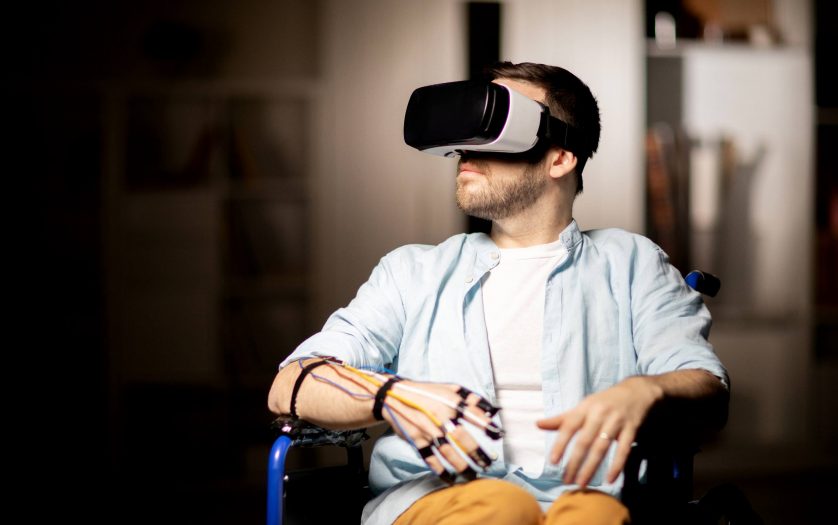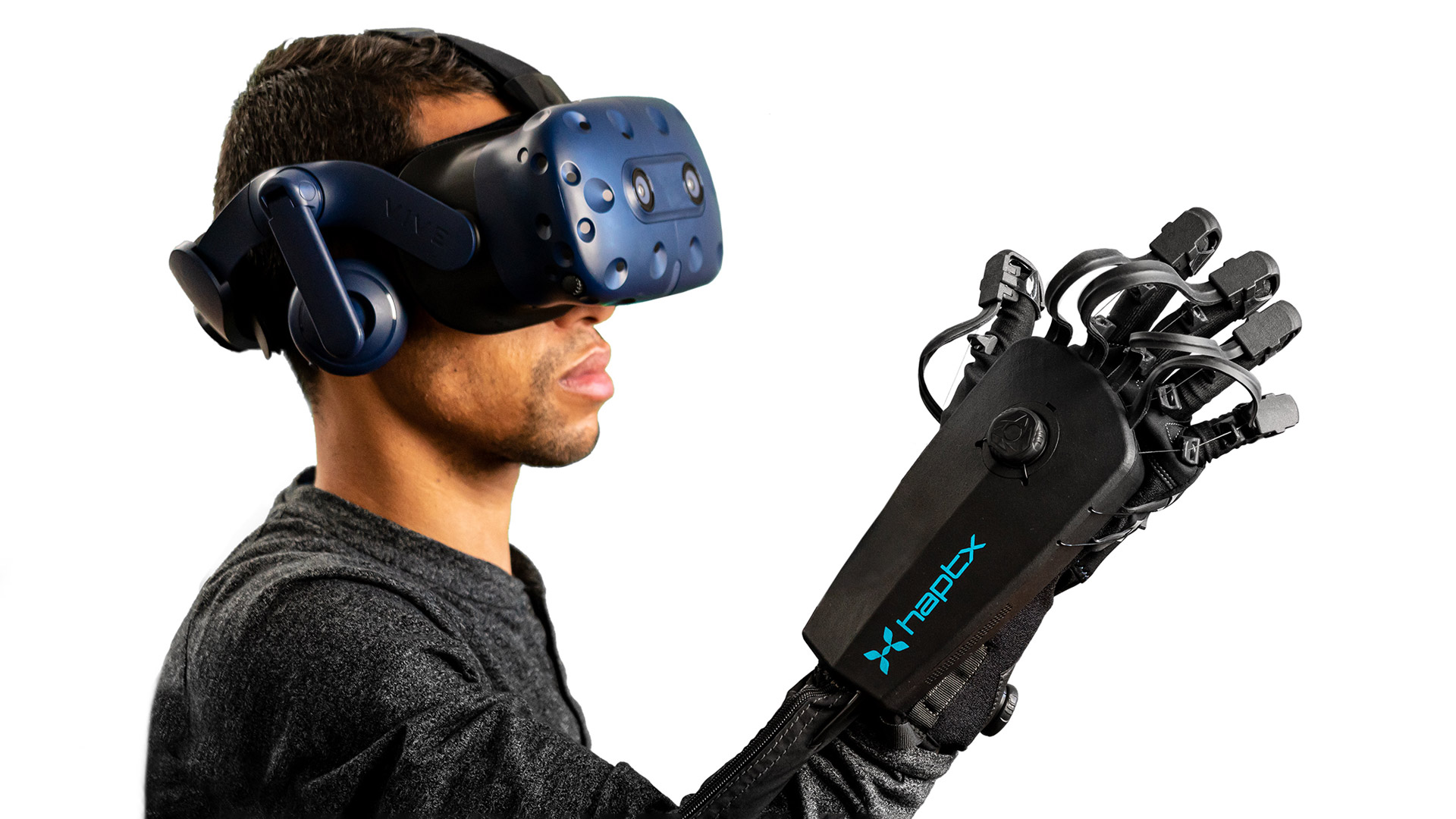Haptics in Stroke Rehabilitation
Introduction[edit | edit source]
Stroke is one of the leading causes of disability which results in minor to severe impairments. Post-stroke sequelae comprise impairments such as loss of range of motion, muscle weakness and motor deficits resulting from impaired force generation.[1] The most common impairment after stroke is reduced upper extremity function. Among these, hand function is commonly impaired after stroke, strongly affecting the power to perform daily activities.[2][3][4] .Virtual Reality-based hand rehabilitation promotes function by providing immediate, appropriate and accurate feedback through audio-visual cues.[5][6] Although there is expansive evidence supporting the use of Virtual Reality in the functional recovery of stroke patients, the integration of haptic feedback is poorly studied.
Background[edit | edit source]
Contextually, the word "haptic" is derived from the Greek verb “to touch” or "to handle". Presently, it refers to the expanding subject that is associated with the study of touch through human computer interaction. The recently emerged haptic technology has developed rapidly and has been the focal point of many research communities. Subsequently, haptic-related products have been deployed commercially, in development, and for research purposes, as well as serving as prototypes. Virtual environments are strongly associated with haptic-based applications. Such environments require the visual sensory channel to produce more realistic sensations. [7] Virtual reality (VR) simulations, can provide an engaging, realistic and motivating environment when linked with robots, movement tracking, and sensing glove systems, where the motion of the limb or tool displayed in the virtual world is a replication of the motion produced in the real world by the subject.[6][5]
Theoretical Framework[edit | edit source]
Various Virtual reality systems have been studied with various Haptic devices employed for the purpose of restoring hand function post-stroke. These devices increase immersion through the application of vibrotactile stimulation with kinaesthetic feedback.[6] This multi-modal feedback has been theorized to improve motor control, strength, and dexterity in integration with the repetitive practice of an ecologically relevant motor task through the mechanism of neuroplasticity.[8][9][10][11][12]
The Sensory side of Motor rehabilitation[edit | edit source]
Evidence on Effectiveness[edit | edit source]
Rehabilitation is an integral component to any program aimed at improving motor function in stroke survivors.[13] [14]Novel strategies are becoming available to overcome the benefits of conventional rehabilitation.9,2
Conclusions[edit | edit source]
Haptic devices enhance motor recovery post-stroke through sensory feedback. Presently such devices are unwieldy, expensive and impractical for daily clinical use. Therefore, economical, smaller and ergonomically designed Haptic devices may allow future studies to make stronger arguments for their inclusion in hand rehabilitation after stroke.
References[edit | edit source]
- ↑ J David, S Alma, T Marilyn, C Grigore, A Sergia, R Michael et al.Virtual Reality Enhanced Stroke Rehabilitation. IEEE Trans. Neural Syst. Rehabilitation Eng. 2001:3
- ↑ Nakayama H, Jorgensen HS, Rasschou HO, Olsen TS. Recovery of upper extremity function in stroke patients: the Copenhagen Stroke Study. Arch Phys Med Rehabil. 1994;75:394–8.
- ↑ Persson HC, Parziali M, Danielsson A, Sunnerhagen KS. Outcome and upper extremity function within 72 hours after the first occasion of stroke in an unselected population at a stroke unit. A part of the SALGOT study. BMC Neurology. 2012;12:162.
- ↑ Hayward, K.S., Kramer, S.F., Thijs, V. et al. A systematic review protocol of timing, efficacy and cost-effectiveness of upper limb therapy for motor recovery post-stroke. Syst Rev 8, 187 (2019).
- ↑ 5.0 5.1 Iosa M. Virtual reality in stroke rehabilitation: virtual results or real values? Arq Neuropsiquiatr. 2019 Oct 24;77(10):679-680. DOI: 10.1590/0004-282X20190123
- ↑ 6.0 6.1 6.2 Merians AS, Fluet GG, Qiu Q, Lafond I, Adamovich SV. Learning in a virtual environment using haptic systems for movement re-education: can this medium be used for remodeling other behaviors and actions? J Sci Technol. 2011 Mar 1;5(2):301-8.
- ↑ Shakra I ,Orozco M ,El Saddak A ,Shirmohammadi S , Lemaire E. Instrumentation for Physical Rehabilitation of Stroke Patients. IEEE Trans. Neural Syst. Rehabilitation Eng.:1-5
- ↑ Levin MF, Magdalon EC, Michaelsen SM, Quevedo AA. Quality of Grasping and the Role of Haptics in a 3-D Immersive Virtual Reality Environment in IndividualsWith Stroke. IEEE Trans Neural Syst Rehabil Eng. 2015 Nov;23(6):1047-55. doi:10.1109/TNSRE.2014.2387412
- ↑ Yeh SC, Lee SH, Chan RC, Wu Y, Zheng LR, Flynn S. The Efficacy of a Haptic-Enhanced Virtual Reality System for Precision Grasp Acquisition in Stroke Rehabilitation. J Healthc Eng. 2017;2017:9840273. doi:10.1155/2017/9840273
- ↑ Lehmann, I., Baer, G. & Schuster-Amft, C. (2017) Experience of an upper limb training program with a non-immersive virtual reality system in patients after stroke: a qualitative study, Physiotherapy. 2017 doi:10.1016/j.physio.2017.03.001
- ↑ Maris A, Coninx K, Seelen H, Truyens V, De Weyer T, Geers R, Lemmens M, CoolenJ, Stupar S, Lamers I, Feys P. The impact of robot-mediated adaptive I-TRAVLE training on impaired upper limb function in chronic stroke. Disabil Rehabil Assist Technol. 2018 Jan;13(1):1-9. doi: 10.1080/17483107.2016.1278467
- ↑ Thielbar KO, Triandafilou KM, Barry AJ, Yuan N, Nishimoto A, Johnson J, Stoykov ME, Tsoupikova D, Kamper DG. Home-based upper extremity stroke therapy using a multi-user virtual reality environment: a randomized trial. Arch Phys Med Rehabil. 2019 Nov 9. pii: S0003-9993(19)31365-6. doi:10.1016/j.apmr.2019.10.182
- ↑ Duncan PW, Zorowitz R, Bates B, Choi JY, Glasberg JJ, Graham GD, Katz RC, Lamberty K, Reker D. Management of adult stroke rehabilitation care: a clinical practice guideline. Stroke. 2005;36:e100 –143.
- ↑ Teasell R, Meyer MJ, McClure A, Pan C, Murie-Fernandez M, Foley N, Salter K. Stroke rehabilitation: an international perspective. Top Stroke Rehabil. 2009;16:44 –56.








